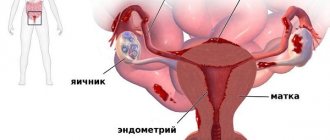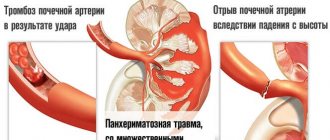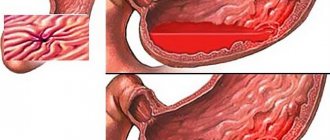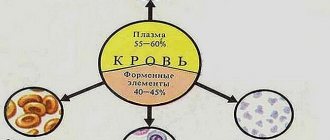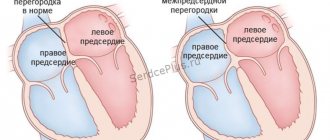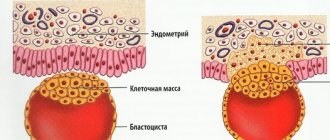Uterine bleeding occurs in women of all ages. They can be a sign of gynecological disease and extragenital pathology, open during a threatened miscarriage or during termination of an ectopic pregnancy. This is a dangerous condition that requires emergency care, so you first need to think about how to stop uterine bleeding.
Causes of uterine bleeding
There are various factors that cause uterine bleeding. This also depends on age, since at different periods of life, the factors that provoke the development of bleeding are varied.
Common causes of uterine bleeding are:
- Problems with the functioning of the thyroid gland - in the presence of hyperthyroidism and hypothyroidism, the likelihood of symptoms of uterine bleeding increases.
- Hormonal imbalances . The most common cause of bleeding in women at a young age and after 40. When hormones are normal, progesterone and estrogen are in optimal balance, blood loss during menstruation is often negligible. If a violation occurs, uterine bleeding occurs.
- Diseases of the circulatory system . When the level of platelets decreases, as well as during a blood disorder, there is a risk of bleeding.
- Uterine fibroids. Particularly heavy bleeding begins with internal fibroids, then the only way out is surgery.
- Adenomyosis . A disease in which the inner and muscular layers of the uterus grow together; menstruation during the disease is painful, prolonged and severe, as the menstrual area increases significantly.
- Polyps . They are benign formations, often occurring in women of childbearing age. When there are many of them and large sizes, they need to be removed, since they are the cause of uterine bleeding and pain during menstruation.
- Ectopic pregnancy , miscarriage, premature placental abruption. Similar consequences during pregnancy have become quite common. During any bleeding during pregnancy, a woman should immediately call a doctor, as bleeding threatens the health of the baby and mother.
- Malignant formations of the genitourinary system. The most serious cause of likely bleeding, regardless of the location of the tumor, during any bleeding, cancer must first be ruled out.
- Breakthrough bleeding of the uterus . The reason is directly related to the use of intrauterine contraceptives. In particular, the likelihood of bleeding increases if you take contraceptives and anticoagulants at the same time. There are minor ones at the beginning of using contraceptives.
Diagnostics
To choose a treatment strategy for a woman, it is necessary to establish the cause of abnormal uterine bleeding. First of all, the doctor collects a gynecological history (information about the development of menstrual function, duration, heaviness and pain of menstruation, the interval between regular bleeding). The presence of complaints indicating hypothyroidism or a disorder of the coagulation system, the fact of taking combined oral contraceptives, anticoagulants and other drugs are also clarified. The presence of an intrauterine device matters.
In case of uterine bleeding, the following tests and examinations may be prescribed:
- General blood analysis. Uterine bleeding is dangerous due to large blood loss. Therefore, it is necessary to know the level of red blood cells and hemoglobin to assess the degree of blood loss.
- Pregnancy test or determination of the level of human chorionic gonadotropin in the blood. The uterus may bleed during a miscarriage or ectopic pregnancy.
- Coagulogram. To determine blood clotting disorders.
- Blood test for hormone levels (TSH, free T4, progesterone). Hypothyroidism and low progesterone levels can cause abnormal bleeding.
- A smear from the cervix for cytology (PAP test) to exclude precancerous and malignant diseases.
- Screening for sexually transmitted infections.
- Ultrasound of the uterus and appendages to detect organic pathology (endometrial pathology, uterine fibroids, ovarian cysts, etc.).
- Separate diagnostic curettage, hysteroscopy, aspiration biopsy of the endometrium. These studies are necessary to exclude precancerous and malignant processes in the uterine body.
In what cases is uterine bleeding considered normal?
- Physiological uterine bleeding is considered only menstruation .
They last from 3 to 5 days, the interval between the old and new cycles is 21-35 days. Total blood loss during the process reaches 50-80 ml. If it is higher than the specified norm, then there is a risk that iron deficiency anemia will appear. Menstruation should occur without pain. They start at 11-15 years old. The function lasts throughout the entire reproductive period, stopping during pregnancy, childbirth and lactation. Menstrual function ends at approximately the age of 45-55 years. - Bloody discharge during menstruation is considered normal. They occur due to sharp fluctuations in the amount of hormones during ovulation, leading to an increase in the permeability of the walls of the uterine vessels. But in certain situations, the occurrence of such discharge in the middle of the cycle indicates the manifestation of hormonal disorders or that inflammation of the uterus has begun, therefore, when characteristic discharge initially appears, you should consult a specialist to rule out this disease.
- Another almost normal type of vaginal discharge that is not associated with menstruation is implantation bleeding, which appears on the 7th day after conception. The reason is the implantation of the embryo into the uterine wall, during which the structure of the uterine mucosa is partially destroyed, which leads to the appearance of insignificant discharge.
What is considered normal?
Gynecologists call only a few types of bleeding from the uterus normal:
- ovulation (in the middle of the cycle when the egg is released);
- implantation (at the time of attachment of the fetus in the uterus);
- regular menstruation.
The first two types of discharge do not occur in all women; they are short-term, not abundant, and indicate the normal course of reproductive processes. Menstruation, which occurs regularly, is a sign of the maturity of the reproductive organs and ensures the body’s readiness for conception.
Any other blood loss is considered abnormal and requires medical attention. To identify dangerous symptoms, you should clearly know the limits of the norm, and for any deviations from which you should contact a gynecologist.
Normal periods
Signs that menstruation occurs without pathologies:
- The period through which normal menstruation occurs ranges from 21 to 35 days. Any deviation to a lesser or greater extent requires additional examination.
- Normally, discharge lasts from 3 days to a week. Sometimes longer periods (up to 10 days) are also not a sign of deviation, but the gynecologist must establish this fact.
- From the beginning to the middle of menstruation, the amount of blood released increases, then gradually decreases.
- The color of the discharge from bright red to brown, even black, is considered the physiological norm.
- The presence of clots of a darker shade indicates the detachment of areas of the uterine epithelium during its renewal. The absence of such clots should alert you, as should their excessive quantity.
The amount of discharge during the entire menstruation does not always correspond to the average norm of 100 ml. If a fully filled pad has to be changed more than once every 2 hours, such menstruation is considered heavy.
Heavy periods
Regular discharge in a large volume does not indicate any violation. If such menstruation is normal and is not accompanied by other unpleasant symptoms, then there is no need to worry. It is worth seeking advice from a gynecologist if there has been a noticeable change in the amount of blood released, and this is not the typical course of menstruation for a woman.
Additional factors for contacting a doctor are pale skin, weakness, and loss of performance. This may be a symptom that bleeding has started and anemia has occurred due to blood loss.
“Disguised” blood loss that occurs during menstruation often goes unnoticed. In itself, such uterine bleeding may be a symptom of a more dangerous disease. If you have heavy periods or bleeding, how can you tell the difference yourself?
Symptoms of bleeding
There are several signs of how to distinguish heavy or irregular menstruation from uterine bleeding. Main symptoms of the pathology:
- the pad or tampon is completely filled within an hour;
- the color of the discharge is scarlet, there are no clots at all or there are more of them than usual;
- on the third day of menstruation, the amount of blood does not decrease or the discharge continues for more than 7 days a month;
- severe pain, fatigue, constant weakness.
Menstrual blood contains enzymes that prevent it from clotting and are responsible for the specific smell of discharge. With abnormal bleeding there is no such smell.
Abnormal discharge may begin mid-cycle, immediately after your period, or during menstruation. Therefore, if you experience any of the symptoms, you should consult a doctor to establish an accurate diagnosis and eliminate the causes of vaginal bleeding.
Types of pathological uterine bleeding
Experts divide these bleedings into a large number of varieties.
But there are some that are more common:
- Acyclic is characterized by the fact that it occurs in the middle of menstrual cycles. It is caused by symptoms such as fibroids, cysts, endometriosis of the uterus and other pathologies. If it happens constantly, you should consult your doctor.
- Juvenile bleeding . Characteristic at the beginning of puberty. They are caused by a number of circumstances, for example, persistent illnesses, high physical activity, and poor diet. Depending on blood loss, they lead to anemia of varying severity.
- Profuse uterine bleeding is quite dangerous when it is accompanied by pain. In such a situation, the amount of blood loss varies. The reasons may include abortion, vaginal infections, and the use of hormonal drugs.
- Anovulatory bleeding is common in women who have reached menopause and in adolescents who are going through puberty. This is due to the fact that the maturation of follicles and the production of progesterone are impaired when ovulation is absent. If left untreated, it provokes the occurrence of malignant neoplasms.
- Dysfunctional uterine bleeding occurs when the functioning of the ovaries is impaired. It differs in that it appears when the menstrual cycle has been absent for a long period, and blood loss is quite severe.
- Hypotonic bleeding occurs due to weak myometrial tone after abortion. Often happens after childbirth.
- Sometimes women may experience bleeding from clots from the uterus. Experts characterize their occurrence by the fact that the uterus undergoes certain anomalies during intrauterine development. Therefore, the blood stagnates inside, forming clots.
Etiology
The main cause of hypotonic bleeding is uterine hypotension in the afterbirth period. Hypotonia is characterized by the appearance of rare spontaneously occurring contractions with a decrease in the degree of contraction and retraction of the myometrial muscle fibers. An extreme degree of decrease in tone, up to its complete absence, is designated as uterine atony. Such conditions lead to the appearance of uterine bleeding, subject to partial or complete separation of the placenta. If the placenta is not separated from the uterine wall, there is no bleeding.
The degree of reaction of the neuromuscular apparatus of the uterus to mechanical, physical and pharmacological stimuli, as a rule, is not adequate to the strength of the stimulus. Paradoxical reactions can be observed in which a strong or prolonged stimulus causes a small mechanical response (contraction), and a weak one causes a higher response.
Uterine hypotension is often a consequence of: a) insufficient stimulation of the uterus and its regulatory systems by hormones of the fetoplacental complex; b) inhibition of individual links of the genetic code responsible for the activation of the normal contractile function of the uterus during childbirth and providing energy for this process; c) morphol, inferiority of the uterus (insufficient development of its structures at the time of birth, scars, foci of inflammation, overstretching, premature involution of intraorgan nervous structures of the myometrium). G. to. occur more often in women in labor whose labor is complicated by weak contractions, late toxicosis, uterine overdistension and endometritis, as well as with surgical methods of delivery.
Hypotonic bleeding in the afterbirth and early postpartum period is not permanent. Blood is released from the uterus in small portions, often in the form of clots, especially when the placenta is separated using the Küstner-Chukalov method (see Sediment period). The first portions of blood with incomplete or even complete separation of the placenta from the uterine wall accumulate in its cavity and vagina without being released completely by the force of uterine contraction. They can be removed from the uterus by squeezing out, if there are appropriate indications for this. The accumulation of blood in the uterus and vagina often creates a false impression of the absence of bleeding, as a result of which the application of methods for separating the placenta and restoring motor function of the uterus is significantly delayed.
Hypotony of the uterus and, as a consequence, bleeding often disappear without any intervention with very careful management of the third stage of labor. Rough manipulations on the uterus and violation of the protective regime of the woman in labor can contribute to the development of G. to.
G. in the early postpartum period can be a continuation of bleeding in the afterbirth period or occur independently with incorrect, overly active management of the third stage of labor. These bleedings have a wave-like nature and may not cause alertness to the obstetrician leading the birth. As a rule, during examination the uterus is flabby, contraction waves are rare and short. After squeezing out the clots (their accumulation impairs the restoration of motor function), the original position of the uterus (in the lower part of the abdominal cavity) is restored relatively quickly.
The degree of impairment of the motor function of the uterus can be clarified by manually separating the placenta or inserting a hand into its cavity for massage with a fist. With normal motor function of the uterus, the force of myometrial contraction is clearly felt with a hand inserted into its cavity. With hypotension, weak contractions are observed in response to mechanical stimulation; with atony - there are no contractions, the uterus does not respond to mechanical stimulation.
Symptoms of uterine bleeding
The main symptom of this pathology is vaginal discharge.
Uterine bleeding has the following characteristics:
- The number of discharges increases. During uterine bleeding, the concentration of blood loss increases and amounts to more than 80 ml.
- The duration of bleeding increases. Lasts over a week.
- Failures in the regularity of discharge - menstruation lasts approximately 21-35 days. Deviation from this norm indicates bleeding.
- Bleeding after sexual intercourse.
- Bleeding in postmenopause.
The following are signs of uterine bleeding:
- Menorrhagia is excessive and prolonged menstruation (more than a week), their regularity does not change.
- Metrorrhagia is intermittent discharge. They appear mostly in the middle of the cycle and are not very intense.
- Menometrorrhagia is prolonged and inconsistent bleeding.
- Polymenorrhea is menstruation that appears more often than after 21 days.
In addition to the above, due to large blood losses, a characteristic sign of such symptoms is iron deficiency anemia. She is accompanied by weakness, shortness of breath, dizziness, and pale skin.
Symptoms
Photo: sovdok.ru
Clinical picture of AUB in the juvenile period
The main characteristic symptom is bleeding from the genital tract, which usually appears after a delay in menstruation. In some cases, uterine bleeding is accompanied by pain in the lower abdomen. The duration of bleeding can reach 1.5 months, but often lasts 3–4 weeks. Prolonged juvenile uterine bleeding leads to the development of posthemorrhagic anemia, resulting in pale and dry skin, general weakness, and periodic dizziness.
Clinical picture of AUB during the reproductive period
The main clinical sign that a woman pays attention to is a disturbance in the rhythm of menstruation. As a rule, bleeding occurs after a delay in menstruation, which can reach 6–8 weeks. Menometrorrhagia - heavy blood loss during menstruation - is somewhat less common. In most cases, bleeding begins as moderate, periodically decreases, but subsequently increases again. The duration of uterine bleeding varies, in some cases reaching 1 - 1.5 months. Prolonged uterine bleeding leads to the development of posthemorrhagic anemia, which significantly weakens the woman’s body.
Clinical picture of AUB in the premenopausal period
Women seek help from a specialist with complaints of heavy bleeding from the genital tract after a delay in menstruation (from 1 to 6 weeks). Against the background of this phenomenon, the following symptoms may appear: general weakness, decreased performance, increased irritability, headache.
According to statistics, approximately 30% of women with premenopausal AUB are diagnosed with menopausal syndrome. In turn, menopausal syndrome is manifested by the following main symptoms:
- hot flashes;
- hyperhidrosis at night;
- facial hyperemia, red spots on the neck;
- painful engorgement of the mammary glands;
- increased or decreased sexual desire;
- sleep disturbance, which manifests itself as nighttime insomnia and daytime sleepiness;
- intolerance to strong odors and loud sounds;
- depressed mood, increased tearfulness, anxiety, depression, apathy.
What is the danger of bleeding from the uterus?
Uterine bleeding is characterized by its ability to increase and not stop for a long period of time and is difficult to stop.
Therefore, depending on the type of bleeding, the following complications can be dangerous:
- Moderate but constant blood loss can cause anemia of varying severity. Occurs if the loss content reaches 80 ml. In this condition, there is no direct threat to health, but it is worth paying attention to.
- Severe blood loss is caused by one-time heavy bleeding that is difficult to stop. In the vast majority of cases, surgery is needed to replace the blood and remove the uterus.
- The danger of subsequent development of the disease . Here we talk about small blood losses, which are not emphasized. In this case, minor blood loss leads to profuse bleeding, or to the fact that the disease that provoked it will progress to a severe stage.
- Bleeding of the uterus during pregnancy or in women who are in the postpartum period is quite dangerous and there is a high risk of transformation into a state of shock. The intensity and severity of this condition is due to the fact that the uterus cannot contract properly and stop the bleeding itself.
Dangers
Why is uterine bleeding dangerous? First of all, during it blood loss occurs, the volume of which is difficult for a woman to estimate. She often has an erroneous opinion, since she defines it subjectively. This is dangerous because a woman may underestimate the degree of blood loss and refuse medical care, which is fraught with dire consequences. Therefore, if you have any irregular or excessive bleeding, you should consult a doctor. The greater the volume of blood loss, the more pronounced symptoms such as weakness, nausea, dizziness, fainting, pale skin, decreased blood pressure, rapid pulse and low blood pressure.
Bleeding in the postmenopausal period indicates a high risk of precancerous pathology or malignant disease of the uterus. Therefore, for any bleeding a year or more after the end of menstruation, as well as for preserved menstrual function in women after 45 years, especially in the presence of risk factors (obesity, scleropolycystic ovary syndrome), separate diagnostic curettage and endometrial biopsy are strongly recommended.
First aid for bleeding
Emergency care for bleeding is to immediately call an ambulance. In particular, this is important when a woman is pregnant, her blood loss is severe, and her condition worsens significantly. In such a situation, every minute is important. When it is not possible to call doctors, you should take the patient to the hospital on your own.
Any bleeding of the uterus poses a significant threat to life, so appropriate actions must be taken.
During dysfunctional bleeding, it is prohibited to apply a hot or warm heating pad to the abdominal area, douche, take baths, or use drugs that help contract the uterus.
On her own, at home before the doctors arrive, a woman should carry out the following manipulations:
- The woman should be placed in bed , on her back, with her legs elevated. For these purposes, place a pillow or cushion. This way you can maintain consciousness, in particular if the blood loss is significant.
- You need to put something cold on your stomach . When there is no heating pad nearby, the ice is wrapped in an ordinary flap. The cold acts for approximately 15-20 minutes , after which - a period of 5 minutes. This way you can achieve the fact that the vessels narrow, and, consequently, bleeding decreases.
- The patient should be given something to drink. Since it is difficult to install an IV at home, you should give her more fluid. Plain water and sweet tea are suitable for these purposes. This facilitates the release of fluid along with blood.
Self-treatment before visiting a gynecologist
If there is heavy uterine bleeding, you must urgently call an ambulance. Before her arrival, you can take the following measures to reduce discharge:
- Lie down so that your legs are higher than your torso.
- Provide plenty of fluids.
- Apply dry ice to the groin area of the abdomen.
After hospitalization and relevant studies and tests, doctors will decide whether the patient should see a gynecologist. Perhaps the symptom requires the intervention of other specialists.
Medications are often used to reduce blood loss: Tranexam, Vikasol, Dicynon. Taking each of these drugs requires consultation with a gynecologist, careful reading of the instructions for use and strict adherence to dosing rules.
How to stop bleeding?
When the ambulance arrives, its actions are as follows:
- A bubble containing ice should be placed in the abdominal area.
- When heavy bleeding begins, the woman should be carried to the car on a stretcher.
- Hospitalize the patient and then transfer her to a doctor.
- Administration of magnesium sulfate solution if there is a risk of miscarriage. If there is a spontaneous abortion, calcium chloride and ascorbic acid are introduced into the woman’s body, which are diluted in glucose.
Experts in clinical settings recommend hormonal drugs for uterine bleeding to stop it, in a similar case when the woman was not pregnant and there is no suspicion of cancer.
Hormonal drugs are Zhannine, Regulon, etc. On the first day, an increased dose is given, then one less tablet, reaching 1 piece. There are cases when gestogens are used, but they are used only if there is no severe anemia.
Sometimes they use drugs that stop bleeding, for example, Dicynon, Vikasol, Ascorutin, Aminocaproic acid.
There are situations when surgery is necessary, for example, curettage of the uterus (a fairly effective way to stop bleeding), cryodisruption (a method without any precautions), laser removal of the endometrium (used in women who do not plan a future pregnancy).
Medicines
It would be advisable to start drug treatment, using in combination the usual and harmless means:
- Vitamin C. Ascorbic acid has an excellent effect on blood vessels, ensuring that bleeding stops anywhere. However, this remedy can only be used with the proper dosage: you need to take quite impressive doses - at least 1 gram of the product per day.
- Vikasol. The medication, which should be used 1 tablet 3 times a day, helps stop uterine bleeding with the help of vitamin K, which has an excellent effect on blood clotting.
- Dicynone . Effectively stops bleeding, the drug has a good effect on the vascular and coagulation system when taking 3-4 tablets per day.
In many cases, the combined use of folk recipes and medications helps to reduce the amount of blood loss or completely stop uterine bleeding.
Folk remedies
As folk remedies for the treatment of uterine bleeding, decoctions and extracts of yarrow, water pepper, shepherd's purse, nettle, raspberry leaves and other plants are used.
The most famous recipes:
- Yarrow herb is infused as follows: 2 hours
Add one tablespoon of dried herb to a glass of boiled water, leave for 1 hour and strain. Drink 4 times a day, a quarter glass before meals. - Shepherd's purse herb is infused as follows : 1 tbsp. a spoonful of dried herbs is poured into a glass of boiled water, infused for 1 hour, wrapped in advance, then filtered. Use 1 tbsp. spoon, 3-4 times a day before meals.
- Stinging nettle is infused as follows: 1 tbsp. a spoonful of dried leaves is poured into a glass of boiled water (10 minutes over low heat), then allowed to cool and strain. Use 1 tbsp. spoon 4-5 times a day.
The use of traditional recipes is allowed only after receiving the recommendations of a specialist, since uterine bleeding is considered a symptom of various diseases, often quite dangerous. Therefore, it is quite important to identify the source of this condition and begin therapy as soon as possible.
Treatment
Rice.
1. Massage of the uterus on a fist: the uterus is shifted anteriorly with the fist of the hand inserted into it, with the other hand light strokes are made through the abdominal wall. Rice. 2. Stopping uterine bleeding by applying fenestrated clamps to the lateral surfaces of the uterus (part of the anterior wall is removed). G.'s treatment should be aimed at quickly restoring normal motor function of the uterus. When G. is associated with retention of parts of the ovum in the uterine cavity, urgent removal of them by hand or with the help of a large blunt curette is indicated (see Curettage, uterus). If pathological bleeding occurs in the afterbirth period (blood loss of 400 ml or more), you must immediately begin squeezing out the placenta, and if unsuccessful, manual separation and removal of it along with the membranes. Methods of external squeezing of the placenta should not be used repeatedly in the afterbirth period, since they do not guarantee its removal, and at the same time worsen the contractile function of the uterus and increase blood loss). Separation and release of the placenta in most cases leads to the restoration of uterine contractions and stopping bleeding, since its removal eliminates the blocking effect of placental progesterone on the motor function of the uterus. The hand inserted into the uterus should not be withdrawn immediately after the placenta is removed. It is necessary to ensure that normal contractions of the uterine myometrium are restored. In the presence of hypotension, the uterus is massaged on the fist (Fig. 1). To do this, the uterus is shifted anteriorly with the fist of the inserted hand, and with the other hand it is lightly stroked through the integument of the anterior abdominal wall. Massage should be carried out carefully. Severe mechanical irritation of the uterus can lead to injury and the appearance of extensive large-focal hemorrhages, which will sharply worsen its already impaired contractile function. At the same time, to stimulate uterine contractions, administration of oxytocin or pituitrin (5-10 units subcutaneously or directly into the myometrium) is indicated. Ergotamine, ergometrine, ergotal, etc. have a good effect. An overdose of these drugs can cause a paradoxical reaction of the uterine myometrium, i.e., further worsen its contractile function. Sometimes a good effect - increased contractile function of the uterus - is observed after placing an ice pack on the lower abdomen. Reflex contraction of the uterus during G. can also be caused by irritation of the receptor fields of the cervix. To do this, a tampon moistened with ether is inserted into the posterior vaginal fornix using a forceps. In combination with other measures, sometimes a transverse suture on the cervix according to Lositskaya has a good effect. Thick catgut is used for this purpose. The suture is removed after 12-20 hours. Various methods of electrical stimulation of the uterus have also been proposed. M. I. Medvedeva used alternating current with a voltage of 5-10 V for stimulation purposes, and Z. A. Chiladze used a direct current discharge with a voltage of 4000 V. If bleeding continues, the use of Baksheev's method is indicated, in which the lateral parts of the uterus are clamped with the help of fenestrated forceps (3-4 on each side). One branch of the clamp is inserted into the uterine cavity, and the other into the lateral fornix in the area of the vascular bundle (Fig. 2). When the vessels are compressed, bleeding decreases and sometimes stops completely. A good effect is also achieved by compressing the uterine vessels with clamps applied to the parametrium area through the lateral vaults of the vagina (Henkel-Tikanadze method). I. E. Tikanadze proposed replacing Muze forceps with intestinal clamps, on which rubber tubes are put, which almost completely eliminates the possibility of damage to the tissues of the vagina, blood vessels, ureter and bladder. Uterine tamponade with G. is not very effective. If bleeding continues, it is necessary to use mechanical methods to stop it: metrohemostat according to Rogovenko, as well as various techniques aimed at compressing the abdominal aorta. G. k. with blood loss exceeding 500-600 ml, can lead to hemodynamic disturbances, and with continued bleeding and insufficient replenishment of the volume of lost blood, it can even cause the death of patients. For blood loss of more than 400 ml or more, a transfusion of freshly preserved blood is indicated. Replenishment of blood loss with plasma substitutes or long-term storage blood can lead to hypofibrinogenemia and increased bleeding even with a well-contracted uterus. With atonic bleeding, which occurs due to complete loss of myometrial tone, conservative measures are not effective. Surgical treatment is indicated: ligation of the uterine vessels and hysterectomy (see).
The prognosis is favorable if treatment measures are started in a timely manner.
What should not be done if bleeding occurs?
Uterine bleeding is a dangerous signal about problems in the female body. And you should respond to it appropriately. First you need to wait for an ambulance or find out the recommendations of a specialist.
Only a specialist can properly assess the condition, since there are a huge number of factors that can provoke uterine bleeding and only clinical practice makes it possible to fully consider the problem.
It is prohibited during bleeding:
- Apply a warm heating pad to the body;
- Perform douching;
- Take a bath in a warm bath;
- Use medications that contract the uterus without the advice of a specialist.
Prevention
- Activities that strengthen the body: proper work and rest schedule, proper nutrition, absence of stress and negative emotions.
- Using 1-2 monthly anti-inflammatory drugs for the first time.
- For the first time , use drugs that stop bleeding for 1-2 months.
- Hormonal therapy. The approximate duration of therapy is from 3 months to six months. The weak effectiveness of such treatment indicates an incorrectly diagnosed cause of bleeding or incorrect selection of the drug or its dosage, susceptibility, or early cessation of therapy.
- Vitamin complex: vitamin C 1 g. per day starting from the 16th day of the cycle, for 10 days; folic acid 1 tablet. per day from the 5th day of the cycle for 10 days; tocopherol acetate for 2 months, multivitamin and mineral products that contain iron and zinc.
- Medicines that calm and stabilize the nervous system.
- Physical education, fitness, swimming, jogging, yoga, and dancing have quite a beneficial
How to treat
Treatment of abnormal uterine bleeding consists of two components. It includes:
- stopping bleeding;
- prevention of recurrent bleeding.
If a woman experiences a similar situation before receiving medical help, she can:
- take a horizontal position with raised legs;
- put cold on your stomach (heat should absolutely not be used, as this will only worsen the situation);
- drink water to replenish fluid loss;
- take a hemostatic drug: dicinone, tranexam, nettle, water pepper extract and others.
To stop and prevent bleeding, your doctor may prescribe combined oral contraceptives and progestin drugs. In case of ineffectiveness of conservative therapy or the need for clarifying diagnostics, hysteroscopy, separate diagnostic curettage, and endometrial biopsy are used. In case of severe bleeding that cannot be stopped by all possible methods, it is even possible to remove the uterus.
